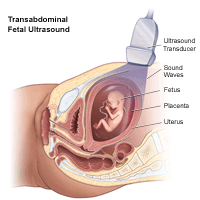First Trimester Screening
What is first trimester screening?
First trimester screening is a combination of fetal ultrasound and maternal blood testing performed during the first trimester of pregnancy. This screening process can help to determine the risk of the fetus having certain birth defects.
There are three parts of first trimester screening:

-
Ultrasound test for fetal nuchal translucency (NT)
Nuchal translucency screening uses an ultrasound test to examine the area at the back of the fetal neck for increased fluid or thickening. -
Two maternal serum (blood) tests
The blood tests measure two substances found in the blood of all pregnant women:-
Pregnancy-associated plasma protein-A (PAPP-A) - a protein produced by the placenta in early pregnancy. Abnormal levels are associated with an increased risk for chromosome abnormality.
-
Human chorionic gonadotropin (hCG) - a hormone produced by the placenta in early pregnancy. Abnormal levels are associated with an increased risk for chromosome abnormality.
-
When used together, nuchal translucency screening and the maternal blood tests have a greater ability to determine if the fetus might have a birth defect, such as Down syndrome, trisomy 18, or trisomy 13.
If first trimester screening is abnormal, additional testing such as chorionic villus sampling, amniocentesis, or other ultrasound procedures may be necessary for accurate diagnosis.
How is first trimester screening performed?
Although the specific details of each procedure vary slightly, first trimester screening generally involves the following tests to be performed between the 10th and 14th weeks of pregnancy:
-
An ultrasound test, usually a transvaginal ultrasound (a small ultrasound transducer is inserted through the vagina), is performed to examine the fetus.
-
Blood is drawn from the mother's vein and sent to the laboratory for analysis.
First trimester screening is not 100 percent accurate. It is only a screening test to determine if there is an increased risk of the fetus having a birth defect. It also helps to identity those women who may need additional testing or monitoring during their pregnancy. There can be false-positive results - indicating a problem when the fetus is actually healthy, or false negative results - indicating a normal result when the fetus actually does have a health problem.